Styles on the Reverse of R8 & R8R Sceatta
Out of the seventy-one coins researched, 59 had a typical LOLII reverse, 83.09%. Out of the total of seventy-one coins this consisted of 49 R8’s 69.01% and ten R8R’s 14.08%. This consisted of a beaded standard with a central annulet surrounded by two L’s and two forty-five degree angled lines pointing to the central annulet. Outside the standard is a short forty-five degree angled line ending in a pellet, one at each corner. Mid-way along each side of the standard, again outside is a cross pommée.
Three coins had a crown above the top of the standard instead of the usual cross pommée. One coin was an R8, EMC 1999.0006, the other two R8R’s, Abramson 185 and British Museum 679. Two coins considered to be from the same die, British Museum 673 and 674, have annulets mid-point on each of the four sides of the standard replacing the usual crosses.
46 R8 and R8R coins with a typical reverse had locations of county recorded. By far the largest group of nineteen, 41.30% were found in Norfolk. The county of Suffolk had ten, 21.73%, Cambridgeshire had seven, 15.21% and Lincolnshire had five coins 10.86% with Leicestershire two, 4.34% and London, North Yorkshire and Hampshire one each, 2.17% each. Out of the ten R8R coins with a typical reverse Norfolk had two recorded. Lincolnshire had two, Suffolk also two and Cambridgeshire one. Three were from an unknown find spot. The two coins with runes interpreted as HHL on the obverse had typical reverses, one came from Cambridgeshire and the other from Lincolnshire.
Of the 58 R8 coins surveyed the largest number were in Type 10, thirteen coins equalling 22.41%. Type 50 had ten coins, 17.24%. Type 30 has eight coins, 13.79%. Type 60 had seven coins, 12.06%. Type 35 had three coins each, 5.17%. Types 18 and 20 had two coins in each type, 3.44% each. All other R8 types had only one coin in each type, 1.72% each.
There were only thirteen R8R coins in the survey. Type 200 had three coins, 23.07%. Type 210 had two coins, 15.38% and Type 237 also had two coins, 15.38%. All other R8R types had only one coin in each type.
Of the total seventy-one coins surveyed, both R8 and R8R coins, Runic combinations of EA numbered twenty-seven 38.02%. Twenty-six, 36.61% had the runic combination EPA on the obverse. The ER combination had twelve coins, 16.90%. The EP combination had four coins, 5.63%. The HHL combination two coins, 2.81%, both of these coins were R8’s.
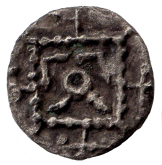
EMC 2015.0398
The above R8 sceat has what is termed a typical LOLII Reverse. It is usual to show images of the Reverse of R8 and R8R coins with the two "L's" at the top of the image.
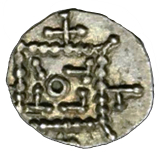
EMC 2016.0169
The above Reverse of a R8 Type 70 coin has unusual symbols within the beaded standard. This coin is number 66 on the Corpus and Die ID Chart
.
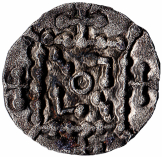
EMC 2018.0188
Coin has typical symbols outside of the Standard but an unusual configuration of symbols within. See image above. See also R8 Type 62. This coin was not included in the original study but has been included in the images retrospectively. The Reverse has two "L's" and two "/'s" but they are in opposing corners rather than adjacent ones. Other coins with the same configuration of symbols on reverse but not necessarily on the obverse can be seen on the EMC database, 1993.9416, 2010.0382 and 2012.0151.
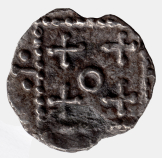
EMC 2016.0321
This R8/E3 "Mule" has four crosses within the beaded standard and unbarred crosses outside the standard.
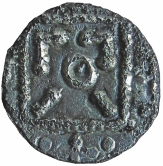
The above image shows the Reverse of a Type R8/45 coin. Note the extra large pellets each side of the Cross Pommée. No EMC number is given as no findspot is available to register the coin. The coin was not included in the original survey, it was purchased subsequently.
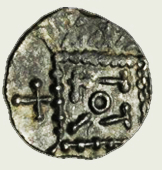
EMC 2017.0046
The Reverse of this R8R coin is very unusual, it has a crown on top of the beaded standard and unusual symbols within the standard. This coin is a Type 245 R8R





